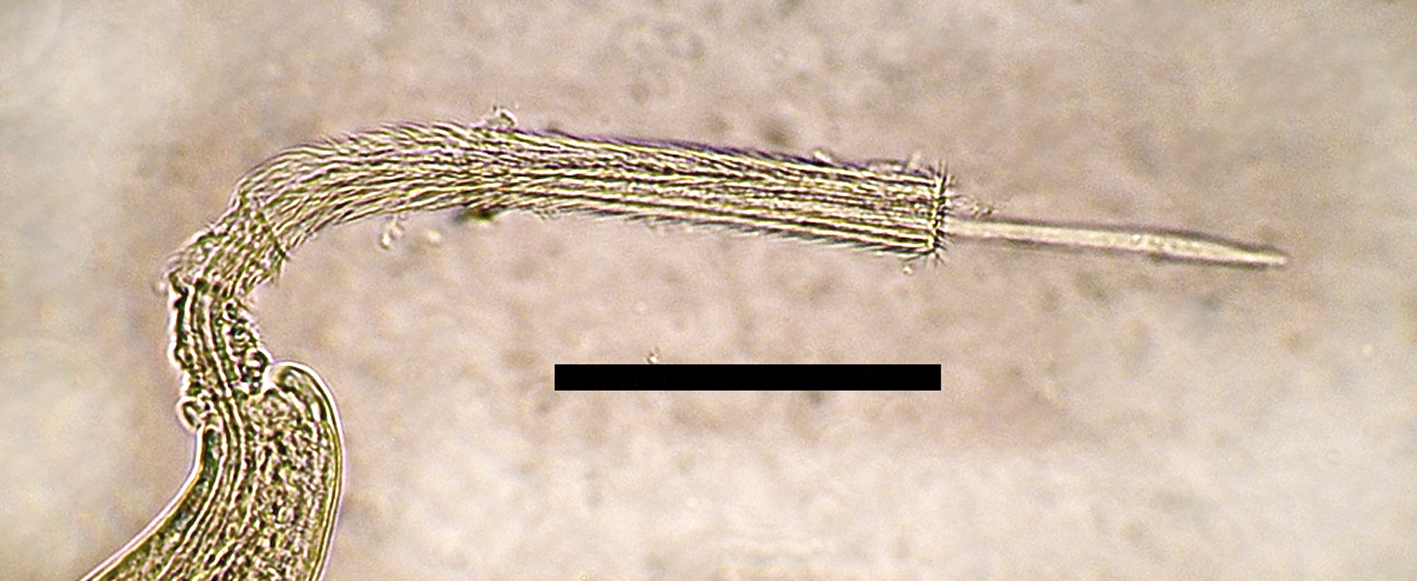Trichinellida on:
[Wikipedia]
[Google]
[Amazon]
The Trichocephalida (Trichinellida or Trichurida in other classifications) is an
Free PDF
(2 subfamilies, 5
 All members of this order are histiotrophic, meaning that in at least one stage of their life cycle, they develop in cells or tissues. They are all parasites in
All members of this order are histiotrophic, meaning that in at least one stage of their life cycle, they develop in cells or tissues. They are all parasites in
order
Order, ORDER or Orders may refer to:
* A socio-political or established or existing order, e.g. World order, Ancien Regime, Pax Britannica
* Categorization, the process in which ideas and objects are recognized, differentiated, and understood
...
of parasitic nematode
The nematodes ( or ; ; ), roundworms or eelworms constitute the phylum Nematoda. Species in the phylum inhabit a broad range of environments. Most species are free-living, feeding on microorganisms, but many are parasitic. Parasitic worms (h ...
s.
Taxonomy
Theorder
Order, ORDER or Orders may refer to:
* A socio-political or established or existing order, e.g. World order, Ancien Regime, Pax Britannica
* Categorization, the process in which ideas and objects are recognized, differentiated, and understood
...
Trichocephalida includes, according to modern classifications, the single suborder Trichinellina Hodda, 2007, which itself includes the single superfamily Trichinelloidea Ward, 1907, which itself includes 6 families:
* Family Anatrichosomatidae Yamaguti, 1961 (1 genus
Genus (; : genera ) is a taxonomic rank above species and below family (taxonomy), family as used in the biological classification of extant taxon, living and fossil organisms as well as Virus classification#ICTV classification, viruses. In bino ...
, 5 species) including the single genus '' Anatrichosoma''
* Family Capillariidae Railliet, 1915 Railliet, A. 1915: L'emploi des médicaments dans le traitement des maladies causées par des Nématodes. ''Recueil de Médecine Vétérinaire, Paris,'' 91, 490–513. ot seen/ref> (1 subfamily, 18-22 genera
Genus (; : genera ) is a taxonomic rank above species and below family as used in the biological classification of living and fossil organisms as well as viruses. In binomial nomenclature, the genus name forms the first part of the binomial s ...
according to classifications,Moravec, F. 2001: Trichinelloid Nematodes parasitic in cold-blooded vertebrates. Academia, Praha, 432 pp. (list of genera of Capillariidae in pages 30-32) () 390 species) including '' Capillaria''
* Family Cystoopsidae Skrjabin, 1923 (2 subfamilies, 2 genera
Genus (; : genera ) is a taxonomic rank above species and below family as used in the biological classification of living and fossil organisms as well as viruses. In binomial nomenclature, the genus name forms the first part of the binomial s ...
, 7 species)
* Family Trichinellidae Ward, 1907 (4 genera
Genus (; : genera ) is a taxonomic rank above species and below family as used in the biological classification of living and fossil organisms as well as viruses. In binomial nomenclature, the genus name forms the first part of the binomial s ...
, 16 species) including ''Trichinella
''Trichinella'' is the genus of parasitic roundworms of the phylum Nematoda that cause trichinosis (also known as trichinellosis). Members of this genus are often called trichinella or trichina worms. A characteristic of Nematoda is the one-way ...
''
* Family Trichosomoididae Hall, 1916Hall, M.C. 1916: Nematode parasites of mammals of the orders Rodentia, Lagomorpha and Hyracoidea. Proceedings of the U.S. National Museum, 50, 1–24Free PDF
(2 subfamilies, 5
genera
Genus (; : genera ) is a taxonomic rank above species and below family as used in the biological classification of living and fossil organisms as well as viruses. In binomial nomenclature, the genus name forms the first part of the binomial s ...
, 25 species) including '' Huffmanela''
* Family Trichuridae
The nematode, roundworm family (biology), family Trichuridae includes the type genus ''Trichuris'' and some less widely known members. They are (after the abolishment of the artificial "Adenophorea" assemblage) placed in subclass Dorylaimia of th ...
Ransom, 1911 (1 subfamily, 6 genera
Genus (; : genera ) is a taxonomic rank above species and below family as used in the biological classification of living and fossil organisms as well as viruses. In binomial nomenclature, the genus name forms the first part of the binomial s ...
, 107 species) including ''Trichuris
''Trichuris'' (synonym ''Trichocephalus''), often referred to as whipworms or the silent serpent (which typically refers to ''T. trichiura'' only in medicine, and to any other species in veterinary medicine), is a Genus–differentia definition, ...
''
Note that another slightly different arrangement of families exists, with the Family Trichosomoididae including '' Anatrichosoma'' in a subfamily Anatrichosomatinae.
Biology
 All members of this order are histiotrophic, meaning that in at least one stage of their life cycle, they develop in cells or tissues. They are all parasites in
All members of this order are histiotrophic, meaning that in at least one stage of their life cycle, they develop in cells or tissues. They are all parasites in vertebrates
Vertebrates () are animals with a vertebral column (backbone or spine), and a cranium, or skull. The vertebral column surrounds and protects the spinal cord, while the cranium protects the brain.
The vertebrates make up the subphylum Vertebra ...
in their adult stage. The anterior end is narrower than the posterior end in most of these worms, and the esophagus
The esophagus (American English), oesophagus (British English), or œsophagus (Œ, archaic spelling) (American and British English spelling differences#ae and oe, see spelling difference) all ; : ((o)e)(œ)sophagi or ((o)e)(œ)sophaguses), c ...
is slender and embedded in cells called stichocytes which form a stichosome. Eggs of members of this order have bipolar or biopercular plugs (except in a few species).
References
{{Taxonbar, from=Q4051744 Parasitic nematodes of vertebrates Nematode orders es:Trichurida sk:Nitkovky